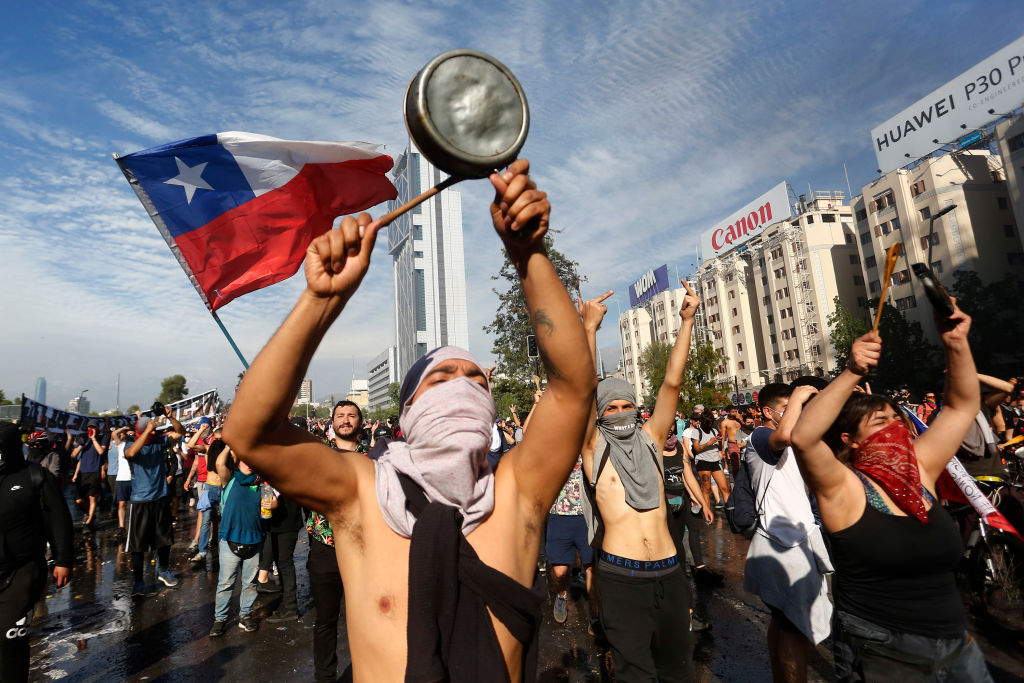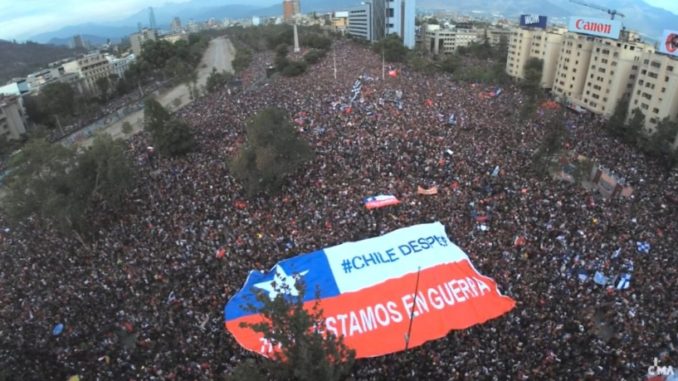Santiago de Chile: Protest and Pandemic


Around six weeks after the start of anti-government protests, I arrived in the Chilean capital of Santiago in November 2019 to start a teaching job. As I flew over the breathtaking Andes to the city of six million, I contemplated a view that would become an unvarying backdrop to daily life. Yet, it definitely wasn’t business as usual for the city and I wasn’t sure what to expect.
My job didn’t start for a month, so I had time to get orientated. Initially I lived with a friend of a friend from Glasgow, and took advantage of my leisure to socialise and explore. I was aware of the ongoing protests from Chilean friends in Scotland and the modest coverage it got in UK media. The scale of the movement when I arrived was hard to fathom. Scale as in the literal size, scale as in intensity (how often people were protesting) and scale as in who was protesting. A broad coalition of protesters had taken to the streets, including, but not limited to; working class Chileans, feminist groups, LGBTQ groups, indigenous communities and students.
Student protests were sparked in October 2019 by a cost increase on Santiago’s already expensive metro. The modern metro system was becoming prohibitively expensive and those who had money didn’t care as they could either afford the prices, or more likely didn’t use the metro. The initial protests had expanded beyond a student movement by the time I arrived. In Santiago itself the larger protests were concentrated in a few plazas in the city centre. The main plaza that protesters usually ended up in was Plaza Baquedano, renamed by protesters as ‘Plaza de la Dignidad’: Dignity Square. As people traveled to and from the protests they were clearly visible in the surrounding centre neighbourhoods of Providencia and Santiago Centro. Outside Santiago centre, protests took hold in both the suburbs of the capital and cities across Chile.


I want to say that the intensity had appeared to calm somewhat by the time I arrived, but it’s perhaps more accurate to say the protests had evolved. There were still various curfews in place, ad hoc protests in the centre of Santiago were not uncommon, and there was usually at least one large gathering in Plaza de la Dignidad at the weekend. These were dissipated by the police using teargas and rubber bullets. Protesters wearing face masks were a common sight in the centre. Walking through the streets of Santiago Centro in the evening, roads were blocked with flaming barricades constructed by protesters. Buildings were covered in fresh anti-government and anti-police graffiti (owners of shops and businesses had invested in metal covering for facades across the city) and the taste and smell of tear gas was ever present. The protesters were challenging the economic model of modern Chile.
Chile’s politics are based on a constitution written during Augusto Pinochet’s dictatorship, which remains largely unchanged. His regime was supported by the then UK Prime Minister Margaret Thatcher, whose attention to shared economic concerns did not extend to human rights abuses. Currently, most of the protesters share a common opposition to the rightwing government of President Sebastian Piñera and the country’s extreme neoliberal economic model. (The roots of these economic policies emerged during Pinochet’s office, tended by the Friedman-influenced ‘Chicago Boys’). Chile’s economy is often hailed as a Latin American success story. Still, looking beyond the headline claims, the success of the few in Chile masks the poverty of many others. The economy is heavily privatised and the wealth is concentrated among these few, embodied by the rule of billionaire Sebastian Piñera.
The average monthly income in Chile is around $800USD and the median monthly income $450USD. This massive difference between average and median income is one indicator of how heavily wealth is concentrated in one direction. When you consider my weekly food shop isn’t any cheaper than buying food in Glasgow, my rent is cheaper, but only marginally, and a one way metro ticket costs around $1USD – it is hard to understand how low-income families in Santiago survive. Protesters’ demands on economic issues ranged from an increase in the minimum salary ($375USD monthly), increased state spending on public health services, to better pension provision and further support for students.
Minority rights were also on protesters’ list of demands, with minority communities at the forefront, adding their voices to ongoing protests against violent police tactics, including rape, use of tear gas, rubber bullets and random detention. These issues existed before the protests, but Piñera’s heavy-handed police response added fuel to the crisis. Despite living in a country where minorities were recently persecuted under a dictatorship, younger Chileans have the confidence to push for such discrimination to be in Chile’s past. An alliance amongst diverse groups of Chileans has created a massive movement for change in the country’s political and economic models, with the broad sentiment that they just want life to be a little bit fairer. Even more affluent middle-class Santiaguinos I have met while working in richer neighbourhoods, such as Las Condes, tended to agree that some form of change was required even if they didn’t agree with the scale and tactics of the protesters.


When the pandemic arrived in Chile, lockdown was implemented from mid-March. A promised referendum on the country’s constitution originally scheduled for April 2020 was delayed. Santiago’s quarantine in particular has been long and strict with some neighbourhoods only starting to gradually open up this week. I was surprised as many employers switched to home working and quarantine was implemented before the UK, even though the pandemic was less developed. This is partly a reflection of the incompetence of the UK government’s response to the pandemic but it was also notable that Chile’s rightwing government locked down so quickly when other rightwing governments were hesitating. Not that I am complaining about a quick lockdown, as we have learned over the last few months, quarantine is effective. Yet in a city expecting a return to protesting in March when the new academic year began, one can still wryly note that it was fortuitous timing for an embattled government to have to lockdown before new protests took hold.
The streets of Santiago and Chile in the main have been quiet over the past few months, but the pandemic has taken a toll on many, especially the poorest. Unemployment has spiked, families have lost their homes and a late COVID-19 peak has meant a lengthy quarantine period. While the people who can work from home do so – those in the country’s biggest industry of mining have continued to keep mines producing throughout lockdown. There has been some protesting in poorer areas by those who have lost their jobs, or were already poor and unable to feed their families. Protests continue on social media, criticising the ongoing response to the pandemic and reasserting the demands of pre-pandemic protests. Cacerolazo (protesting from home by banging pots and pans) occurs every week or two in response to government policies; to commemorate anniversaries of protestors that have been killed or to celebrate a victory. The government’s financial response to aid Chileans, viewed as lacklustre by many, includes food boxes for the poorest and some small amounts of financial aid for specific people. Recently the Chilean Congress passed a law to allow Chileans to withdraw 10% of their pension plan early, an opposition victory. President Piñera could have vetoed the move, but instead signed the bill into law, likely fearing further protests regardless of the quarantine.
As the country starts to tentatively emerge from quarantine, having paused large scale protests for almost 5 months, if anything, the pandemic has further emphasised the deep inequalities in Chile. Much of what happens in the immediate future will be dictated by the pandemic, especially if further quarantine is required. Protesters may have been understanding of the delay to the vote on the new constitution, but it is still a potential lightning rod for discontent – and in rescheduling the referendum for 25 October this year, the government at least seems to be prepared here to meet its commitments. Voters will also go to the polls in November 2021 to elect a new President and New National Congress. Despite President Piñera (a focus of the protests) being unable to stand for election for a consecutive term, the heated politics of Chile will continue in 2021 with the unpredictability of the pandemic making an already difficult situation that much more complicated.
Image credit: Marcelo Hernandez

Is the US still heavily involved in propping up the neo-liberal regime in Chile, and in effective nuetralisation of any anti-neo-liberal opposition leaders?
Perhaps direct political influence isn’t obvious in a way it is in other counties right now. But economically there are a lot of large US corporations that operate here and the economic model is still very similar to the US model.
Many thanks for this Ian. I’m old enough that I remember vividly the bombing and murder of Allende by Pinochet’s CIA-supported thugs, and it’s seared in my memory as few other political events are. As is the welcome extended by the Scots left and trades unions, to the thousands of political refugees we adopted in the seventies.
There were tears in my son’s eyes when I took him to the first showing of ‘Nae Pasaran’ at the GFT a few years ago. Now it’s time for Scots to develop new solidarity with the people of Chile.